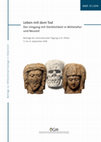Papers by Roman Skomorowski

In: T. Kühtreiber/R. Risy/G. Scharrer-Liška/C. Theune (Hrsg.), Leben mit dem Tod. Der Umgang mit Sterblichkeit in Mittelalter und Neuzeit. Beiträge der internationalen Tagung in St. Pölten 11. bis 15. September 2018. Beiträge zur Mittelalterarchäologie in Österreich 35 , 2020
This study presents for the first time the early medieval
cemetery of Podersdorf am See in its la... more This study presents for the first time the early medieval
cemetery of Podersdorf am See in its landscape archaeological,
diachronic context. The interdisciplinary methods applied
show the cemetery in a completely unexpected dense
spatial setting, with additional cemeteries, settlements and
roads, over a time span reaching from the Roman Empire
Period, through the Migration Period to the Middle Ages.
Change in burial customs in Eastern Austria during the
1st millennium AD is discussed based on the case study of
the early medieval cemetery at Podersdorf. Animal bones
and composite bows are among the regular grave goods that
remained in the graves there despite deliberate looting. The anthropological evaluation of the skeletons from Podersdorf
allows these grave goods to be seen from a new perspective.
A special feature was the discovery of a pit house directly
north of the cemetery. The burial of five individuals
inside the building, two of whom were positioned in a
foetal posture, is unusual in this form in the second half of
the 7th century. Using aDNA analysis, it was possible for the
first time to prove family relationships between such „deviant
burials“
Fundberichte aus Österreich, 2019
Third preliminary report about the excavations of an early medieval cemetery and settlement next ... more Third preliminary report about the excavations of an early medieval cemetery and settlement next to the lake Neusiedl (Fertö-tó) (7th century AD).
Second preliminary report about the excavations of an early medieval cemetery next to the lake Ne... more Second preliminary report about the excavations of an early medieval cemetery next to the lake Neusiedl (Fertö-tó) (7th century AD).
Preliminary report about the excavations of an early medieval cemetery next to the lake Neusiedl ... more Preliminary report about the excavations of an early medieval cemetery next to the lake Neusiedl (Fertö-tó) (7th century AD).
Articles by Roman Skomorowski

Uploads
Papers by Roman Skomorowski
cemetery of Podersdorf am See in its landscape archaeological,
diachronic context. The interdisciplinary methods applied
show the cemetery in a completely unexpected dense
spatial setting, with additional cemeteries, settlements and
roads, over a time span reaching from the Roman Empire
Period, through the Migration Period to the Middle Ages.
Change in burial customs in Eastern Austria during the
1st millennium AD is discussed based on the case study of
the early medieval cemetery at Podersdorf. Animal bones
and composite bows are among the regular grave goods that
remained in the graves there despite deliberate looting. The anthropological evaluation of the skeletons from Podersdorf
allows these grave goods to be seen from a new perspective.
A special feature was the discovery of a pit house directly
north of the cemetery. The burial of five individuals
inside the building, two of whom were positioned in a
foetal posture, is unusual in this form in the second half of
the 7th century. Using aDNA analysis, it was possible for the
first time to prove family relationships between such „deviant
burials“
Articles by Roman Skomorowski
cemetery of Podersdorf am See in its landscape archaeological,
diachronic context. The interdisciplinary methods applied
show the cemetery in a completely unexpected dense
spatial setting, with additional cemeteries, settlements and
roads, over a time span reaching from the Roman Empire
Period, through the Migration Period to the Middle Ages.
Change in burial customs in Eastern Austria during the
1st millennium AD is discussed based on the case study of
the early medieval cemetery at Podersdorf. Animal bones
and composite bows are among the regular grave goods that
remained in the graves there despite deliberate looting. The anthropological evaluation of the skeletons from Podersdorf
allows these grave goods to be seen from a new perspective.
A special feature was the discovery of a pit house directly
north of the cemetery. The burial of five individuals
inside the building, two of whom were positioned in a
foetal posture, is unusual in this form in the second half of
the 7th century. Using aDNA analysis, it was possible for the
first time to prove family relationships between such „deviant
burials“